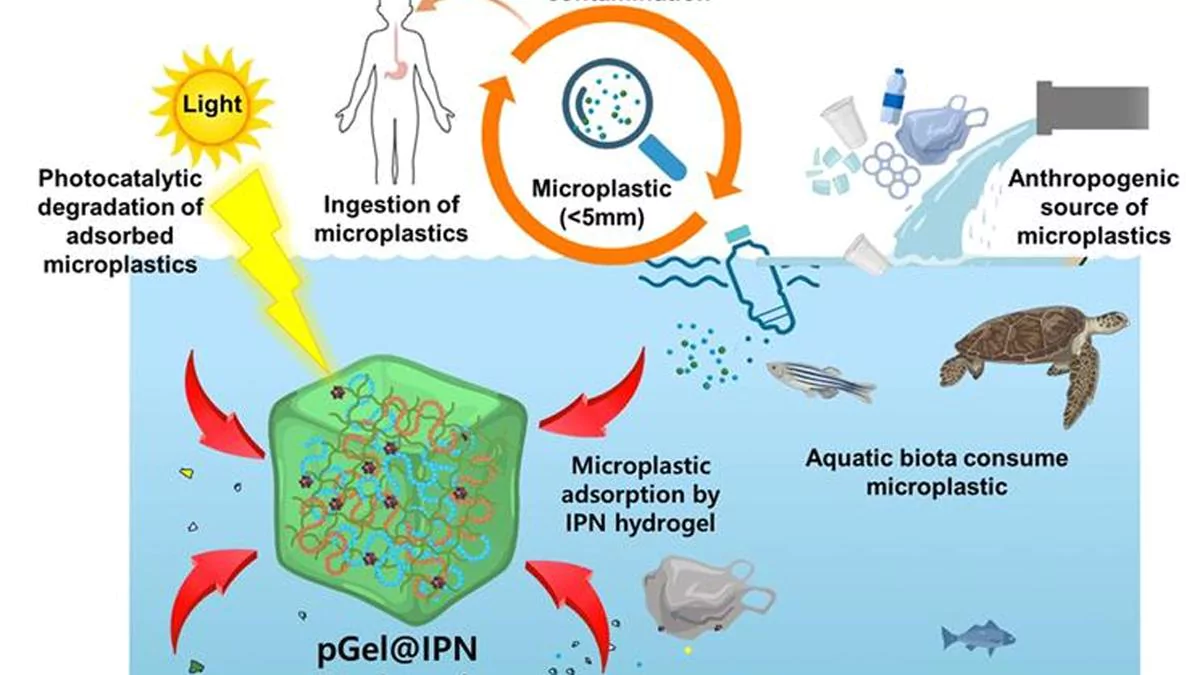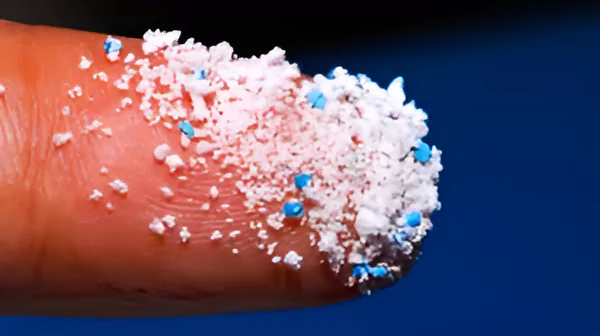Context
Researchers at the Indian Institute of Science (IISc) have designed a sustainable hydrogel to remove microplastics from water.
Novel Hydrogel Removes Microplastics from Water: IISc

- Risks of Microplastics: According to IISc, microplastics pose a great threat to human health as these tiny plastic debris can enter human bodies through the water and increase the risk of illnesses.
- They are an environmental hazard and found even in remote areas such as polar ice caps and deep ocean trenches, endangering aquatic and terrestrial lifeforms.
- Intertwined Polymer Network (IPN): The sustainable hydrogel has a unique intertwined polymer network that can bind the contaminants and degrade them using UV light irradiation.
- The novel hydrogel consists of three different polymer layers – chitosan, polyvinyl alcohol and polyaniline – intertwined together, making an IPN architecture.
- Scientists have previously tried using filtering membranes to remove microplastics. However, the membranes can become clogged with these tiny particles, rendering them unsustainable.
- Integration of Nanoclusters: The team infused this matrix with nanoclusters of a material called copper substitute polyoxometalate (Cu-POM).
- These nanoclusters are catalysts that can use UV light to degrade the microplastics.
- The combination of the polymers and nanoclusters resulted in a strong hydrogel with the ability to adsorb and degrade large amounts of microplastics.
- Addition of Fluorescent Dye for Tracking: The researchers added a fluorescent dye to the microplastics to track how much was being adsorbed and degraded by the hydrogel under different conditions.
- Efficiency in Removing Microplastics: The hydrogel was found to be highly efficient as it could remove about 95% and 93% of two different types of microplastics in water at near-neutral pH (∼6.5).
- Due to their minuscule size, these particles are imperceptible to the naked eye.
- Stability of Hydrogel: The team also carried out several experiments to test the durability and strength of the material.
- The combination of the three polymers made it stable under various temperatures.
Enroll now for UPSC Online Course
Government initiatives to tackle Plastics Pollution
- International Convention for the Prevention of Pollution from Ships (MARPOL): India is a member of MARPOL.
- It is the main international convention covering prevention of pollution of the marine environment by ships from operational or accidental causes.
- The MARPOL Convention was adopted on 2 November 1973 at IMO.
- India Plastics Pact: It was launched in September 2021. It aims to create a circular economy for plastics in India by holding its signatories to four ambitious and time-bound targets.
- Project REPLAN: It stands for REducing PLastic in Nature. It aims to make carry bags by mixing processed and treated plastic waste with cotton fiber rags in the ratio of 20:80.
- Un-Plastic Collective: It is co-founded by the Confederation of Indian Industry, United Nations Environment Programme and WWF-India, a movement to minimize single use plastic.
- GloLitter Partnerships Project: It is launched by the International Maritime Organization and the Food and Agriculture Organization of the United Nations to prevent and reduce marine plastic litter from shipping and fisheries.
|
Microplastics

- About: Microplastics are extremely small plastic particles.
- Size Range: These particles range from 100 nanometers (nm) to 5 millimeters (mm).
- Sources: They come from various places such as plastic waste, the breakdown of larger plastic items, and industrial activities.
- Widespread Presence: Microplastics are everywhere, including oceans, rivers, soil, and even the air.
- Detection Challenges: Their tiny size makes them difficult to detect without special equipment.
Also Read: India’s Single Use Plastic Crisis
To get PDF version, Please click on "Print PDF" button.


